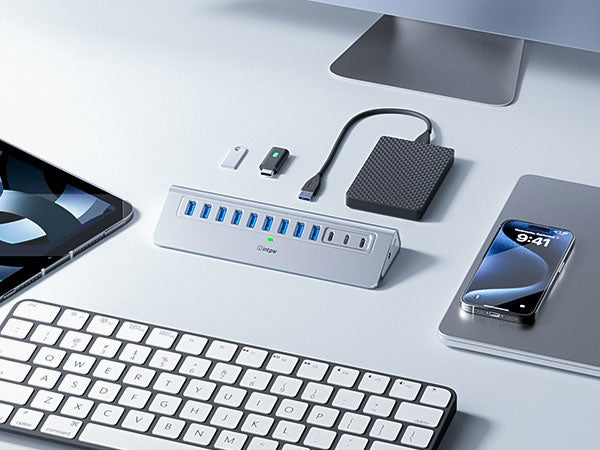
USB Hub vs. Docking Station: Which One Do You Need?
, by USintpw, 8 min reading time

, by USintpw, 8 min reading time
Confused about the difference between a docking station and a USB hub? This guide explains what each device does, and its key features, and helps you decide which one is right for your needs—whether you need extra USB ports, multiple connections, or a full desktop setup for your laptop.
In today’s world of technology, having the right accessories for your devices is more important than ever. Whether you're working from home, gaming, or simply managing a variety of devices, you may find that your laptop or desktop doesn't have enough ports to accommodate everything you need to connect. This is where USB hubs and docking stations come in.
While both devices are designed to expand your computer’s connectivity options, they serve different purposes and are suited to different needs. If you're confused about which one to choose, don’t worry! In this post, we’ll break down the key differences between hubs and docking stations, and help you decide which one is best for you.
A USB hub is a simple device that connects to your computer’s USB port and provides additional USB ports for your peripherals. Such as a mouse, keyboard, external hard drive, printer, or USB flash drive. Essentially, it acts as a splitter, expanding the number of devices you can connect to your computer at the same time. This is especially useful if a limited number of USB ports on your laptop or desktop.
Unpowered USB Hubs:
These hubs don’t have a power supply. They rely on the power from your computer’s USB port to transfer data. They’re best for low-power devices like a keyboard, mouse, or USB flash drives. If you plug in a power-hungry device, such as an external hard drive, the hub may not be able to supply enough power.
Powered USB Hubs:
These hubs come with an external power adapter, meaning they can provide additional power to the devices connected to them. Powered USB hubs are ideal for devices that require more power, such as external hard drives, printers, or scanners. These hubs allow your devices to operate independently of your computer’s power supply.
A docking station is a more advanced device designed to provide a full desktop experience when used with a laptop. It connects to your laptop or computer via USB-C, USB 3.0, Thunderbolt, power delivery port, or even a proprietary connector and expands the available ports. It is easy to connect peripherals.
Besides adding more USB ports, docking stations often include additional functionality, such as HDMI or DisplayPort for connecting external monitors, Ethernet for wired internet, audio jacks for speakers or headphones, and even SD card readers.
In many cases, docking stations can also charge your laptop, offering a one-cable solution for data transfer, power, and external connections.
USB-C Docking Stations:
These are the most common for modern laptops with USB-C ports. They offer fast data transfer speeds and a reliable connection.
Thunderbolt Docking Stations:
These offer even faster data speeds compared to USB-C docking stations. They can support more high-performance devices like multiple 4K monitors or high-speed external storage. However, Thunderbolt docking stations tend to be more expensive.
While USB hubs and docking stations both expand your computer’s ports, they are for different use cases. Let’s compare their features in more detail.
USB Hub:
- The main purpose of a USB hub is to expand the number of USB ports on your computer. If you only need to connect additional USB devices, like a mouse, keyboard, or external hard drive.
- A USB hub is a simple and effective solution. It doesn’t offer other types of connections, such as video or Ethernet. And usually doesn’t allow you to charge your laptop.
Docking Station:
- A docking station offers much more functionality than a USB hub. In addition to USB ports, it provides other types of connections. Such as HDMI or DisplayPort for connecting external monitors, Ethernet for wired internet, and audio jacks for headphones or speakers.
- Many docking stations also have SD card readers, making them a great choice for photographers or videographers. A docking station essentially turns your laptop into a desktop computer, giving you access to all the necessary ports and features you need.
USB Hub:
- Most USB hubs only provide USB ports (USB-A, USB-C, or both). So if you need other types of connections—such as video output, Ethernet, or audio, you’ll need to look elsewhere.
- Some advanced USB hubs might include an HDMI or Ethernet port, but these are usually basic versions and are not intended to handle high-performance needs. Such as connecting multiple monitors or accessing gigabit Ethernet speeds.
Docking Station:
- A docking station offers a wide variety of ports, which is ideal if you need to connect multiple types of devices.
- Besides USB, docking stations often include HDMI or DisplayPort for connecting high-definition monitors, Ethernet for fast and stable internet, audio jacks for sound, and even SD card readers for transferring files from cameras or other devices.
- Some advanced docking stations also feature Thunderbolt ports or even legacy ports like VGA for older devices.
USB Hub:
- Unpowered USB hubs rely on the power from your computer to transfer data. These are best for devices that don’t require much power, such as a keyboard, mouse, or flash drive.
- Powered hubs, have their power source and can provide additional power to connected devices. This is especially helpful when using power-hungry devices like external hard drives or printers. However, powered USB hubs typically don’t charge your laptop.
Docking Station:
- Many docking stations come with the ability to charge your laptop. This means that, in addition to providing extra ports, you can also use the docking station to keep your laptop powered while you’re connected to multiple devices.
- This can be especially convenient in a desk setup where you want to minimize cable clutter by using a single cable for both charging and data transfer.
USB Hub:
- USB hubs are compact, lightweight, and easy to carry around. They are ideal for people who need to add more USB ports to their laptops or desktops on the go.
- If you travel frequently or need to expand your connectivity while working in different locations, a USB hub is a portable solution that you can easily slip into your bag.
Docking Station:
- Docking stations are usually larger and less portable than USB hubs. They are designed to sit on your desk and act as a central hub for all your devices. While they offer more functionality, they are meant for stationary use.
- Docking stations are typically not something you would carry around with you, as they are designed to stay in one location.
USB Hub:
- USB hubs are generally more affordable than docking stations. You can find basic USB hubs for as little as $10 to $30, depending on the number of ports and features.
- Powered hubs may cost a bit more, but they are still relatively inexpensive compared to docking stations.
Docking Station:
- Docking stations tend to be more expensive, with prices ranging from $50 to over $200. The higher price is due to the additional functionality they offer, such as multiple types of ports, the ability to charge your laptop, and support for high-performance devices like external monitors or storage.
A USB hub is the best option if:
- You only need extra USB ports for connecting devices like a mouse, keyboard, external hard drive, or flash drive.
- You don’t need additional ports like HDMI, Ethernet, or audio.
- You want something small, portable, and inexpensive.
- You need a simple solution that allows you to connect more USB devices without the need for a full desktop setup.
A docking station is the best option if:
- You need to connect multiple types of devices, such as monitors, printers, Ethernet, and audio equipment.
- You want to charge your laptop while using it.
- You use your laptop as your primary computer and need a more permanent desktop setup.
- You want to maximize your productivity by having a single connection that provides both power and connectivity to all your devices.
Both USB hubs and docking stations serve important roles in expanding the connectivity of your laptop or desktop.
If you just need more USB ports to connect a few devices, a USB hub is an affordable and portable solution.
However, if you want to transform your laptop into a full desktop experience with access to multiple types of ports and charging capabilities, a docking station is the way to go.
Ultimately, your choice depends on your specific needs. If you’re looking for something lightweight, portable, and easy to use, a USB hub will work just fine.
But if you need a more robust solution with added functionality for your entire workspace, a docking station will give you everything you need.
No matter which one you choose, both devices can make your tech life more organized, productive, and efficient.

Subscribe to our emails